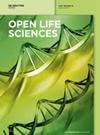中国新疆汉族和维吾尔族乳腺癌患者 CYP2D6 和 CYP2C19 基因多态性的分布情况
IF 1.7
4区 生物学
Q3 BIOLOGY
引用次数: 0
摘要
本研究旨在调查新疆汉族和维吾尔族绝经前乳腺癌患者体内细胞色素P450(CYP450)酶CYP2D6和CYP2C19的频率分布及他莫昔芬的代谢形式,以指导临床合理用药。研究选取2011年6月1日至2013年12月1日期间在新疆维吾尔自治区肿瘤医院接受治疗的绝经前激素受体阳性乳腺癌汉族患者125例和维吾尔族患者121例。使用 TaqMan® minor groove binder 技术分析了 CYP450 的常见突变位点。通过基因检测确定他莫昔芬的其他代谢类型,并使用Chi-squared检验比较基因型和代谢类型。汉族组和维吾尔族组之间,CYP2D6(*10/*10)和 CYP2C19(*1/*1)基因型的频率存在显著差异,P 值分别为 0.002 和 0.015。两组患者的 CYP2D6(*1/*1)、CYP2D6(*1/*5)、CYP2D6(*5/*5)、CYP2D6(*5/*10)和 CYP2C19(*3/*3)基因型均有表达,差异无统计学意义(P >0.05)。在汉族患者中,他莫昔芬广泛代谢者、中等代谢者和不良代谢者的比例分别为 72%、24% 和 4%,而在维吾尔族患者中分别为 76.9%、17.4% 和 5.7%,差异无统计学意义(P > 0.05)。总之,汉族和维吾尔族绝经前乳腺癌患者 CYP450 的 CYP2D6 和 CYP2C19 基因多态性存在部分差异,但 CYP2D6 和 CYP2C19 表型无显著差异。要确定 CYP450 的酶基因差异与他莫昔芬的药代动力学和疗效之间的关系,还需要进一步的研究。虽然汉族和维吾尔族乳腺癌患者的基因型存在一些差异,但这些差异并没有导致预测的他莫昔芬代谢表型的差异。因此,应根据个人基因型数据调整剂量。本文章由计算机程序翻译,如有差异,请以英文原文为准。
Distribution of CYP2D6 and CYP2C19 gene polymorphisms in Han and Uygur populations with breast cancer in Xinjiang, China
The aim of this study was to investigate the frequency distribution of the cytochrome P450 (CYP450 ) enzymes, CYP2D6 and CYP2C19 , and the form of tamoxifen metabolisat ion in premenopausal patients with breast cancer in the Han and Uygur ethnic groups of Xinjiang to guide rational clinical drug use. A total of 125 Han patients and 121 Uygur patients with premenopausal hormone-receptor-positive breast cancer treated at the Xinjiang Uygur Autonomous Region Cancer Hospital between 1 June 2011 and 1 December 2013 were selected. The common mutation sites in CYP450 were analysed using TaqMan® minor groove binder technology. Genetic testing was performed to determine other metabolic types of tamoxifen, and the genotypes and metabolic types were compared using a Chi-squared test. Between the Han and Uygur groups, there were significant differences in the frequencies of the CYP2D6 (*10/*10) and CYP2C19 (*1/*1) genotypes, with P- values of 0.002 and 0.015, respectively. Genotypes of CYP2D6 (*1/*1), CYP2D6 (*1/*5), CYP2D6 (*5/*5), CYP2D6 (*5/*10) and CYP2C19 (*3/*3) were expressed in the two patient groups, and the difference was not statistically significant (P > 0.05). In the Han patients, the proportions of extensive, intermediate and poor metabolisers of tamoxifen were 72, 24 and 4%, respectively, whereas those in the Uygur patients were 76.9, 17.4 and 5.7%, respectively, with no significant difference (P > 0.05). In conclusion, There were partial differences in the CYP2D6 and CYP2C19 gene polymorphisms of CYP450 between the Han and Uygur patients with premenopausal breast cancer, but there was no significant difference between the CYP2D6 and CYP2C19 phenotypes. Further research is needed to determine the relationship between the enzyme genetic differences of CYP450 and the pharmacokinetics and efficacy of tamoxifen. Although there were some differences in genotypes, these did not result in differences in the predicted tamoxifen metabolisation phenotype between the Han and Uygur patients with breast cancer. Therefore, the doses should be adjusted according to the individual genotype data.
求助全文
通过发布文献求助,成功后即可免费获取论文全文。
去求助
来源期刊

Open Life Sciences
BIOLOGY-
CiteScore
2.50
自引率
4.50%
发文量
131
审稿时长
43 weeks
期刊介绍:
Open Life Sciences (previously Central European Journal of Biology) is a fast growing peer-reviewed journal, devoted to scholarly research in all areas of life sciences, such as molecular biology, plant science, biotechnology, cell biology, biochemistry, biophysics, microbiology and virology, ecology, differentiation and development, genetics and many others. Open Life Sciences assures top quality of published data through critical peer review and editorial involvement throughout the whole publication process. Thanks to the Open Access model of publishing, it also offers unrestricted access to published articles for all users.
 求助内容:
求助内容: 应助结果提醒方式:
应助结果提醒方式:


